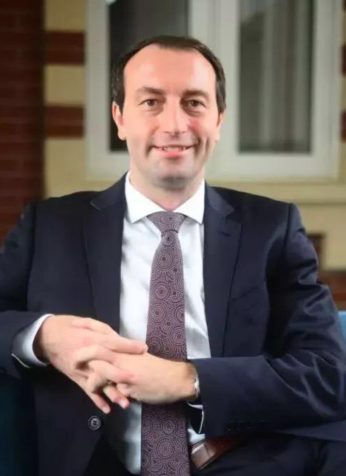Educational Insights | Leadership: What Works?

Dr. Ahmed Hussain
Wellington College Education (China)
Senior Director of Academics
About the author: Dr. Hussain is leading the great Institute of Learning in addition to working across the Wellington College Education (China) group on all academic related issues and providing outreach support outside of the Wellington group."Culture eats strategy for breakfast."--Peter Drucker
All great schools have a culture of excellence
In my humble opinion, all great schools have a culture of excellence. A culture that is tangible and immediately conveys what the school is about and its future direction. Culture creation is a common theme in leadership literature (Berger, 2003), but it is ultimately the leader that lays out the fabric that is woven into the culture of a school. A great school is led by individuals that possess a clear definition of their moral purpose, why they are there and what they are striving to achieve. Jim Collins (2002) describes this as the 'hedgehog' effect in which successful leaders hold a deep passion, a distinct sense of what they want to be excellent at and a defined set of criteria that make the organisation successful."Students' achievement and character are shaped by the culture around them. Regardless of their background, when students enter a culture that demands and supports quality work and moral character, they tend to work to fit into that culture. Once they enter a school culture with a powerful virtuous ethic, that ethic becomes their norm. It's what they know. "--Ron Berger
So how to achieve a culture of excellence?
Firstly, I believe excellence is just as unique as each school is distinct. Excellence is more than a set of pubic exam results or university destinations, although academic success is integral. Great leaders define excellence in the context of their school and codify how to achieve it. Secondly, they talk about it, live it and measure it. The latter point I postulate is essential since unless one has a distinct sense of what it will look, feel and sound like when excellence is taking shape, how else can one truly lead a school towards it."Prescribe adequacy, unleash greatness."--Mourshed and Barber, 2010
Effective distribution of leadership throughout the school
Hattie (2009) proposes that "what works best for students, also works best for teachers". He goes on to suggest that this involves teachers setting high expectation of themselves and being clear about what success as a teacher entails. This view suggests that teachers and leaders take ownership and are active in determining the direction of travel of a pupil, class or school. To achieve this, I uphold that the way forward is effective distribution of leadership throughout the school. Distributed leadership is an emergent property of a collection of individuals or an organisation, a form of organisational capacity that is fluid and dynamic (Harris, 2008). Thus, the leader of a great school entrusts and empowers carefully and strategically the leaders, teachers, and dare I suggest pupils, to take ownership for their craft and to evaluate how they are performing against shared and personal goals. Ownership to find solutions to the questions raised in the complexity of learning, teaching and schools. The practice of distributing leadership is complex and fraught with set-backs, but within a culture of unwavering commitment to achieve excellence, and through a careful balance of accountability and support, allows individuals within the community to grow and develop. They each become agents within the culture. In great schools, a tipping point in the agents is achieved and these determine the culture. Great schools do not put limits on what pupils or teachers can achieve, they scaffold them in charting their journey to excellence."Go looking for it and you will find it."
Establish a dynamic measurement system
If a leader is to entrust leadership to those she/he leads, they must have an accurate means of evaluating the current position towards achieving excellence. It is often regarded as a dirty word, but I believe good leaders "measure" how close or far the school is from realising excellence. To do this, a system is established that draws on a wide range of evidence sources to inform a judgment at key points in time about what is going well and what needs to improve. Effective systems look beyond the confines of a learning walk or tracking pupil progress, although these are essential, they record attitude, skills and engagement(Coe, 2014). Only through a genuinely accurate measure of the status of the school, can a leader point the school towards greatness."…successful schools have a much more demanding culture, a hunger for improvement, while less successful schools have less of a press on improvement."--Fullan, 2001
Value professional learning
In my experience, I have never encountered a great school that has not valued and placed significant emphasis on professional learning. However, I believe that traditional approaches to CPD are more often than not ineffective. Leaders in great schools, do not take this risk. Instead they engage in high impact professional learning that equips teachers with the necessary tools to be agents in achieving excellent. But what works for professional learning? Drawing on the work of Guskey (2009) and Coe et al. (2015), I suggest that professional development has high impact if:A universal focus on learning
Finally, great schools are underpinned by a universal focus on learning. That is each and every member of the community views learning as their goal, starting with the leader. Robinson (2008) in her meta-analysis of what effective leaders do demonstrated that the relative effective size on learning when leaders promote and participate in developments of teaching (0.84) is double that for more traditional features of effective leadership such as goal setting, strategic resourcing, coordinating and evaluating teams and ensuring systems are effective (0.27-0.42). This coherently fits with points 3 and 4 above relating to monitoring and professional learning, in that leaders in great schools are centrally focused on learning. So there it is. Leadership: what works? Culture, distributed leadership, effective monitoring of learning and teaching supported by high impact professional learning. Oh! All this is underpinned by an unrelating focus on learning, for the leader of a great school has to be a leader of learning.- Berger, R (2003) An Ethic of Excellence: Building a Culture of Craftsmanship With Students. (Plymouth, NH: Heinemann).
- Coe, R et al. (2014) What makes great teaching? Review of the underpinning research.
- Cordingley, P., Higgins, S., Greany, T., Buckler, N., Coles-Jordan, D., Crisp, B., Saunders, L., Coe, R. (2015) Developing Great Teaching: Lessons from the international reviews into effective professional development. Teacher Development Trust. tdtrust.orgabout/dgt/
- Collins, J (2002) Good to great: why some companies make the leap and others don't.
- Drucker (2006). "Classic Drucker: Essential Wisdom of Peter Drucker from the Pages of Harvard Business Review", p.3, Harvard Business Press
- Fullan M (2001) Leading a Culture of Change. (San Francisco: Jossey-Bass).
- Harris, A. (2008). Distributed leadership: According to the evidence. Journal ofEducational Administration, 46(2), 172-188.
- Hattie (2009) Visible learning.
- Mourshed M and Barber M How the World's Most Improved School Systems Keep Getting Better (McKinsey & Company, 2010)
- Robinson, V. M. J., Lloyd, C., & Rowe, K. J. (2008). The impact of leadership on student outcomes: An analysis of the differential effects of leadership type. Educational Administration Quarterly, 44(5), 635 - 674.
- Sinek, S. (2009). Start with why: How great leaders inspire everyone to take action. Penguin.
- Thomas R. Guskey And Kwang Suk Yoon, What Works in Professional Development?, Phi Delta Kappan, Vol. 90, No. 07, March 2009, pp. 495-500.
Related Articles








 Channel
Channel 
 Linkedin
Linkedin  Facebook
Facebook  Ins
Ins 






